Table of contents
- Introduction
- Anger Perspective
- Definition
- DrTJ’s Anger-Meter
- Parked in the Red Segment
- Concept of Anger
- Triggers
- Types of Anger Expression
- Vocal, Passive-Aggressiveness, or Sarcasm
- Repressed Anger
- Constructive Anger
- Antidote for Anger
- Duration of Anger
- Effects of Anger on the Body
- Body’s Response to Anger
- States More Susceptible to Anger
- Personal Episode
- Anger Management Techniques
- Conclusion
- Author
Introduction
Anger is a powerful emotion. However, it is considered a secondary emotion.
In other words, a secondary emotion is thought to be fueled by other emotions. For instance, feeling hurt can be the primary emotion and anger the secondary emotion. It is easier to express anger than hurt, which makes you feel vulnerable.
Moreover, anger is also a threat response that is linked to a strong sense of annoyance. Therefore, when it comes to a perceived or real threat and survival, both fear and anger play a role.
Anger usually expels all rational and logical thinking in the human mind. For instance, uncontrolled anger can transform you from a human being to a human beast!
Robert Ingersoll said, “Anger is a wind which blows out the lamp of the mind.”
Above all, when someone is angry, it often makes them behave irrationally. This makes people around them very uncomfortable. This includes the person gripped by anger.
Anger Perspective
Anger has many faces—namely, the good, the bad, and the ugly. Therefore, one has to have courage to face up to one’s anger, fully analyze its role in your life, and then take every step to minimize or eliminate one’s anger.
Definition
The dictionary definition of anger is “a strong feeling of displeasure and usually of antagonism.”
DrTJ’s Anger-Meter
I like to look at my anger-meter as consisting of triple colors. These colors occupy equal segments. The bottom segment is green, and the top segment is red. The yellow segment is sandwiched between the green and red segments, much like a traffic signal.
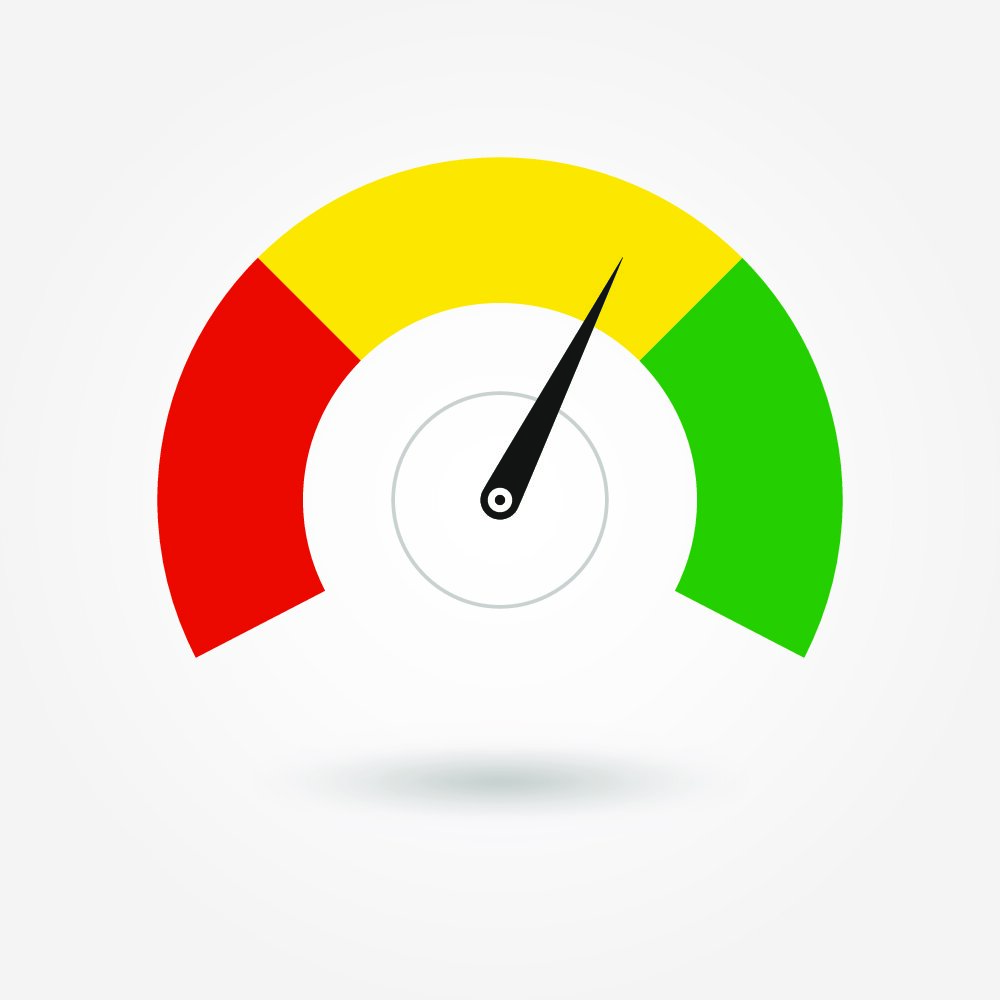
Green, Yellow, and Red Segments of Anger
When you are angry, you usually are in one of these three segments. However, you may also move from one segment to another while angry. In other words, you don’t have to be locked into one segment during the entire period you are angry, although you can be.
Green Segment
Firstly, the green segment is the safest zone on the anger meter. This segment tells you that you are getting mildly angry.
Mild anger may be likened to the dark clouds you see just before a storm. Moreover, if you remain in this green zone, you usually are safe. In addition, you don’t often say anything to get others upset.

Yellow Segment
Secondly, the yellow segment is where your anger continues to escalate and amplify rapidly.
This yellow segment may be compared to a sudden weather change. For instance, all of a sudden, a sunny day becomes dark, then very dark, with rapidly intensifying cloud density, but not a drop of rain yet.

Above all, while you are in this yellow zone, if you know anger-management techniques, you might be successful in reversing the direction and end up in the safe green zone.
Red Segment
Thirdly, if you lack the ability to control your anger, then escalation of anger will likely move you from the yellow to the red danger segment. As a result, you often erupt in an explosion of anger and rage.
After that, this eruption may manifest in screaming, yelling loudly, cursing, throwing objects, punching walls, breaking objects, and inflicting physical harm.

In other words, it is like the storm has erupted with a torrential downpour of rain, accompanied by thunder and lightning.

Parked in the Red Segment
Usually, if you’ve reached the red segment, it is very difficult to change direction and go immediately to the green segment.
As a result, you stay in the red segment until the anger finally abates. In other words, it is like being parked in this red segment.
Concept of Anger
Anger is often considered a sleeping lion.

If you wake the lion, a major problem ensues. In other words, if you can avoid getting angry in the first place, you will be better off. That way, you don’t wake up the sleeping lion of anger.
Remember, your anger can come in the way, and dampen your progress towards your success. Therefore, you need to overcome this obstacle to improve your overall quality of life.


Triggers
While anger has many different triggers, one trigger is based on expectation. Let us look at this expectation.
When your expectation is met, you are satisfied and there is no anger. However, not having your expectation met triggers anger. As a result, this anger then wakes up the sleeping lion.
Types of Anger Expression
Vocal, Passive-Aggressiveness, or Sarcasm
At least three types of anger expression exist. The first is the most common, where you use strong words or foul language to vent your anger, or it may even escalate into physical violence. The second is passive-aggressive behavior, and the third is the use of sarcasm.

Repressed Anger
Let us now look at repressed anger. Keeping anger inside for extended periods is often detrimental. For instance, it can cause heart disease, raise the risk of stroke, weaken the immune system, cause depression, and even shorten one’s lifespan.
Constructive Anger
A prevailing concept is that anger can be good for you. In other words, it may be considered constructive anger. Moreover, anger is meant to keep us safe. When we are faced with an adversary or dangerous situation, anger sets off the fight-or-flight response meant to protect us.
Anger can push us faster toward our goals. Therefore, it can help us solve problems or obstacles. In addition, it can make us more assertive. Above all, it can even energize us.
Channeling anger in a positive direction rather than in the negative or destructive mode is usually beneficial. However, I personally like to eliminate anger if possible, or at least decrease anger to its minimum.
Think of what Mark Twain said, “Anger is an acid that can do more harm to the vessel in which it is stored than to anything on which it is poured.”
Antidote for Anger
Anger has no antidote. However, through practice, you can learn anger-management techniques to tame and possibly control your anger and save a situation and relationship. Therefore, this practice means you need to get out of your comfort zone and take action to master your anger-management techniques.
To move away from anger to a more relaxed state, you need to activate the parasympathetic nervous system.
Duration of Anger
According to anger-management expert Ronald Potter-Efron, PhD, the neurological process that triggers anger lasts less than two seconds. However, once anger explodes, the duration of anger varies from person to person.
Effects of Anger on the Body
Fight-or-Flight Response
When you get angry, a cascade of events gets you ready for the fight-or-flight response. This process is initiated by the amygdala, the most primitive part of the brain.
Amygdala
Anger causes the small amygdala to send an SOS signal to the command center, called the hypothalamus.
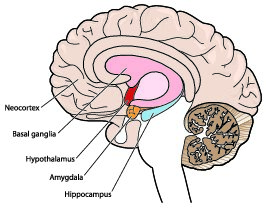
Hypothalamus
The hypothalamus then springs into action and sends signals to the tiny adrenal glands above your kidneys. The hypothalamus does this with the help of the pituitary gland.
Adrenal Glands
The adrenal glands then spring into action, pouring epinephrine, also called adrenaline, into your bloodstream. In addition, shortly, thereafter, they also secrete cortisol.

Body’s Response to Anger
Bang! Now everything goes up—your blood pressure, your heart rate, and your rate of breathing. Your muscles tighten, and you often begin to sweat.
Above all, you are now ready for the fight-or-flight response. After that, you stand up and fight, or turn around and run for your life.
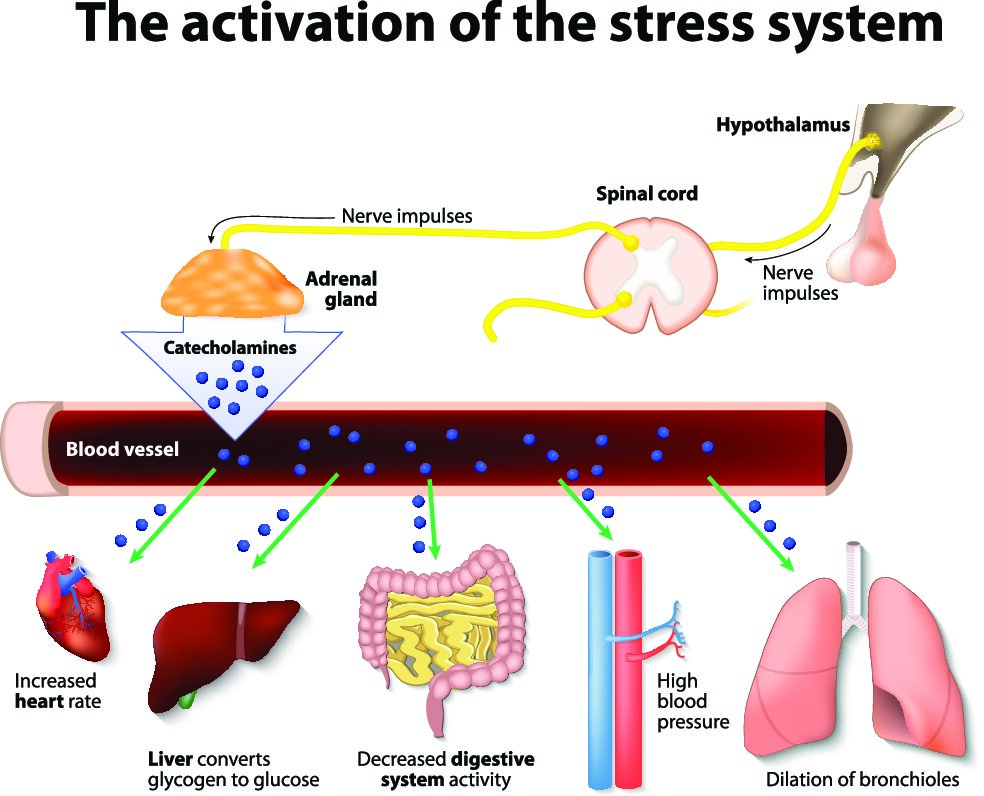
Frontal Lobes
In addition to the amygdala, another important player is the frontal lobes. Frontal lobe is part of the neocortex (See image above). They are considered to be the control panel.
Amygdala versus Frontal Lobes
When you are angry or exposed to a threat, who is in command? In other words, is it the amygdala or the frontal lobes (part of the brain’s cerebral cortex)? This depends on the situation’s intensity.
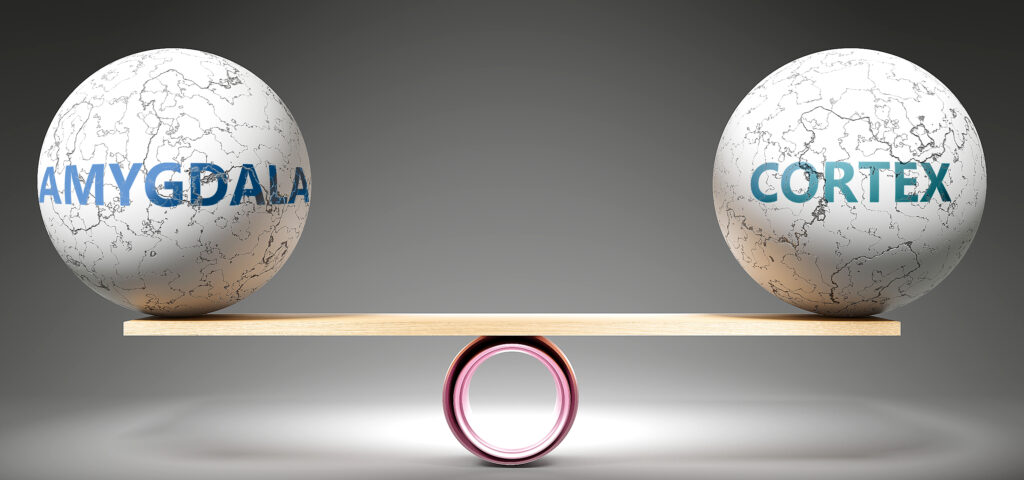
Mild Anger – Frontal Lobe Dominates
When the threat is small and the anger is mild, meaning in the green segment of the anger meter, the frontal lobes override the amygdala. Therefore, you respond rationally, and you control your response.
Severe Anger – Amygdala Dominates, Amygdala Hijack
However, when the threat is intense and the anger is greater, meaning you are in the red segment of the anger meter, the amygdala has the upper hand.
As a result, the amygdala then disables the frontal lobes. This process is referred to as the amygdala hijack. Therefore, when there is an amygdala hijack, you shift from refined controlled behavior to a more primitive fight-or-flight response.
Mental Confusion
Without the frontal lobes, you can no longer think clearly, indulge in rational decisions, or control your responses.
States More Susceptible to Anger
Being hungry, tired, or sleep deprived are all setups to get angry easily. In other words, they lower the threshold for anger to be triggered. Therefore, if you are in these pre-anger states, be extra-careful not to get agitated by external stimuli.
Personal Episode
Now, I’d like to share a personal experience of anger, and how it changed me. One time when I was hungry and, in a hurry, —that is in a more susceptible state to anger—I entered a fast-food drive-thru.

When I realized I had been given something other than what I had ordered, I got angry and raised my voice at the person at the service counter. Later that day, back at home, I heard my daughter crying. She said it was because I had yelled at the person at the restaurant. I told my daughter I was in the wrong and I was sorry. She was only twelve years old. However, she made me open my eyes and realize I was at fault for getting angry.
Above all, that was an important turning point in my life. After that, I have made every attempt to control, curtail, and diffuse any anger within.
Anger Management Techniques
Anger management techniques include deep breathing, counting to ten, and meditation.

Deep breathing redirects the blood from the extremities back to the brain. This process helps us to think better. In addition, it moves us toward a more logical and rational mental state. Above all, deep breathing helps to calm us, so we get less angry.
Counting to ten uses both time and distraction as a way out of anger emotion. Meditation diminishes the body’s physical response to anger.
Conclusion
In conclusion, don’t wake the angry lion within. If you sense you are getting angry, try to diffuse it by using the anger-management techniques listed above.
There are three steps to diminish or eliminate your anger. First, use courage to face up to your anger, second, take action to learn anger-management techniques, and lastly, be persistent to complete learning your anger-management techniques.
The less your anger, the greater your happiness within.
Allow me to end with this question: Do you want happiness, or do you want anger to be your life’s companion? The choice is yours!

References
- https://www.merriam-webster.com/dictionary/anger
- https://www.psychpoint.com/mental-health/articles/what-is-anger-a-secondary-emotion/
- https://www.goodtherapy.org/blog/value-of-anger-16-reasons-its-good-to-get-angry-0313175
- https://www.webmd.com/sex-relationships/features/anger-management-counting-to-ten#1
- https://www.health.harvard.edu/staying-healthy/understanding-the-stress-response
- https://www.healthline.com/health/anxiety/anxiety-and-anger
- https://www.apa.org/helpcenter/stress/effects-nervous
- https://meditationsphere.com/meditation-for-anger/
- https://www.healthline.com/health/stress/amygdala-hijack
- https://www.healthline.com/health/what-part-of-the-brain-controls-emotions#:~:text=Much%20like%20fear%2C%20anger%20is%20a%20response%20to,the%20fight%20as%20part%20of%20the%20fight-or-flight%20response.
- https://www.learning-mind.com/repressed-anger/#:~:text=Keeping%20anger%20inside%20for%20long%20periods%20of%20time,1.%20Repressing%20anger%20is%20associated%20with%20heart%20disease
- https://momentousinstitute.org/blog/brain-basics#:~:text=The%20amygdala%20is%20the%20most%20primitive%20part%20of,applies%20here%29.%20The%20amygdala%20also%20responds%20to%20novelty.
- https://h-ealthy.net/how-anger-affects-the-brain-and-body/#:~:text=1%20The%20first%20spark%20of%20anger%20activates%20the,the%20adrenal%20glands%20by%20releasing%20adrenocorticotropic%20hormone%20%28ACTH%29.
- https://www.psychologytoday.com/us/blog/passive-aggressive-diaries/201610/understanding-passive-aggressive-behavior
- https://www.psychologytoday.com/us/blog/stronger-the-broken-places/201907/sarcasm
Author
DrTJ (Thomas John, MD, DTM) is the author of Your Lifeonomics: Take Action Now to Immediately Improve Your Life.
Visit him at speakerdrtj.com. Email: drtj@speakerdrtj.com. Click here to order your copy of the book: Your Lifeonomcs

“DrTJ” / Thomas John, MD, DTM, is an international best-selling medical author, professional keynote speaker, personal coach, motivational speaker, and corporate leadership and sales trainer.
He has delivered numerous medical speeches as an invited speaker and keynote speaker both in the United States and worldwide. He has been featured globally on TV and has appeared on The Doctors Show.
Internationally, he has been invited to speak in Canada, Italy, India, South Africa, Serbia, Argentina, Greece, Brazil, Mexico, Peru, and Finland. He is listed in Chicago’s Top Doctors, America’s Top Doctors, and America’s Top Ophthalmologists. He has been featured in leading newspapers and magazines in the United States and abroad.
Dr. TJ is also a rock ’n’ roll drummer, dancer (ballroom, line, disco), and writer.
If you want a powerful, inspiring motivational and professional keynote speaker who will leave your audience members with an impactful experience they will never forget, book DrTJ today!
If you want to transform your life for the better, look no further. Make DrTJ your personal life coach!

Order copy of this life changing book today!Click here
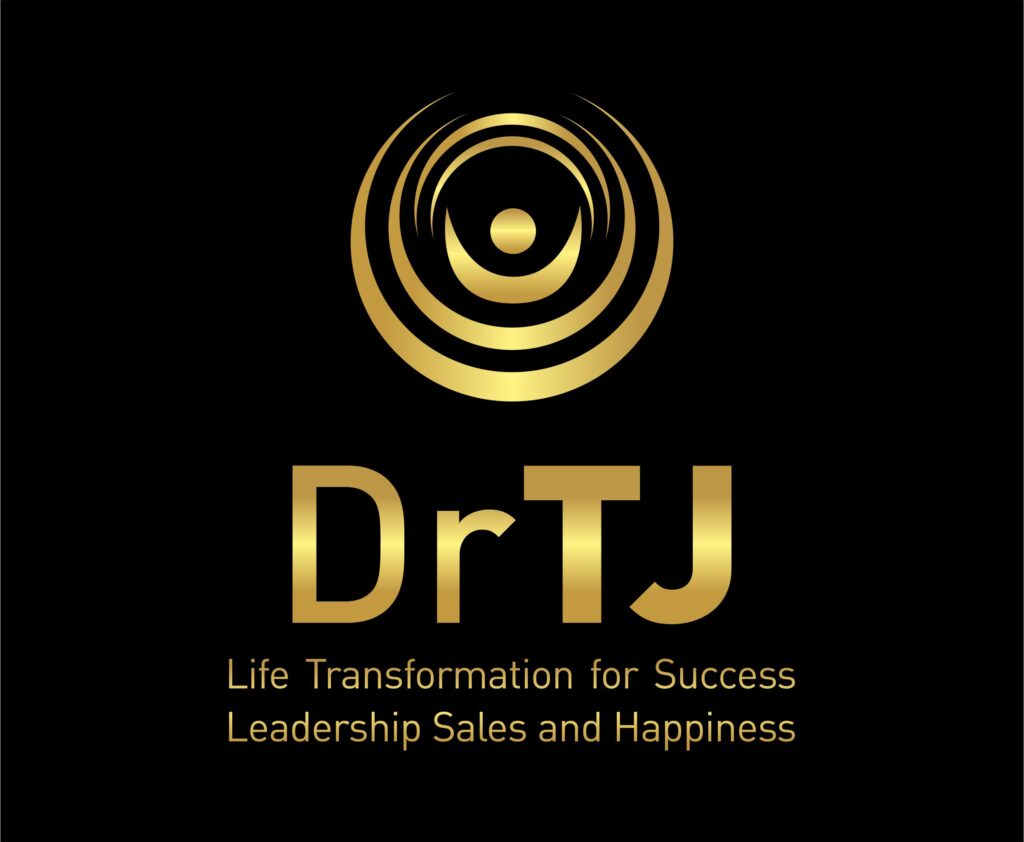
Disclaimer
This blog is merely information – not advice. If users need medical advice, they should consult a doctor or other appropriate medical professional.
Your Lifeonomics, LLC
Latest posts by DrTJ (see all)
- Emotional Intelligence: The Secret to Building Strong Relationships and Achieving Success - April 17, 2023
- Procrastination – Definition, Perspective, and Overcoming It - February 15, 2021
- Breaking Point, Boiling Point, and Beyond - February 5, 2021

Good reading. Hope I can remember your points when things happen.
Intentional or not, Dr TJ’s analysis of anger is most timely and applicable to our current president’s reaction to his re-election loss. He is most certainly in the “Red Zone”. This has potentially grave consequences for our country. Also, the United States is collectively in the “Red Zone”, triggered by the COVID pandemic and racial tension. Let’s hope and pray that the anger won’t lead to physical violence. We need to transition quickly through the Yellow and Green Zones away from anger.
Thanks Dr TJ for focusing our attention on important concerns.